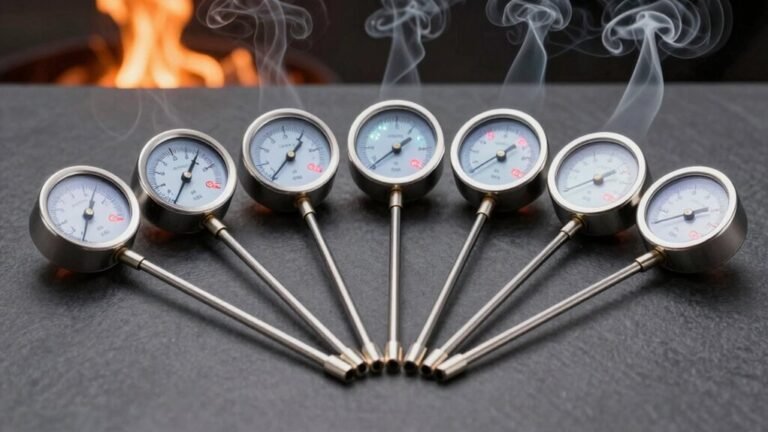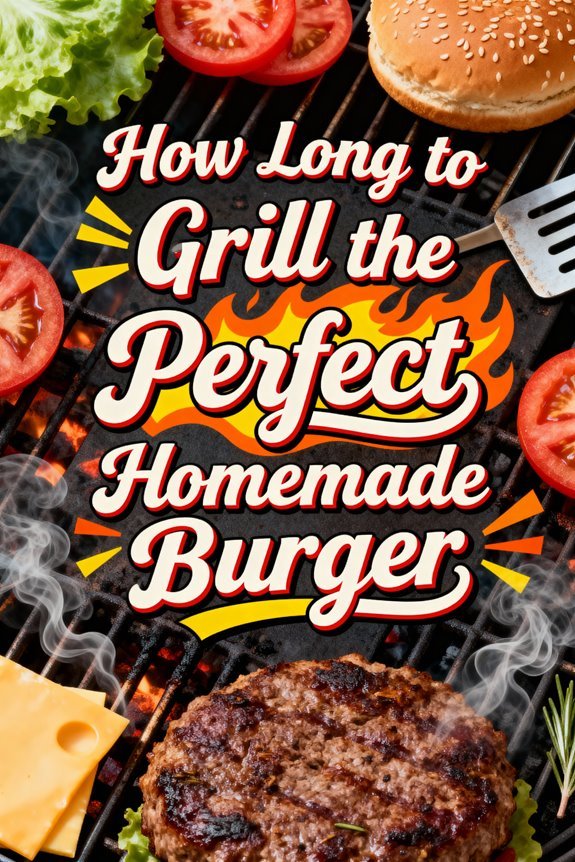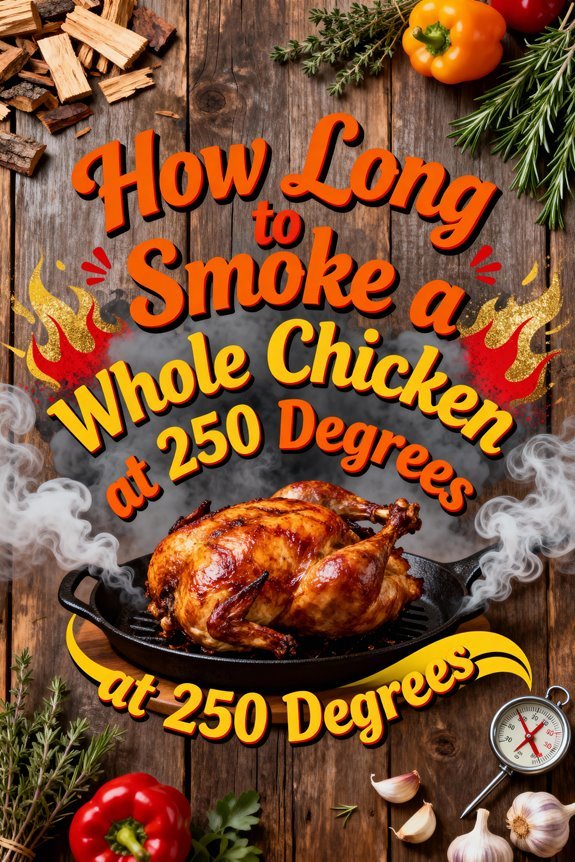You’ll need to grill your steak for 9-10 minutes total for a one-inch cut at 450-500°F. Remove it from heat when the internal temperature reaches 125°F—it’ll climb to the perfect 130-135°F during resting. For thinner ½-inch steaks, aim for 5 minutes total; ¾-inch cuts require 7 minutes. Always insert your thermometer through the side into the thickest part, then let the steak rest for 5-10 minutes before serving. Master these fundamentals and you’ll uncover advanced techniques that elevate your results even further.
Understanding the Ideal Temperature for Medium-Rare
Precision defines the difference between a perfectly grilled medium-rare steak and a disappointing meal. Your target internal temperature sits between 130°F and 135°F (54°–57°C), where marbling melts to enhance tenderness and flavor. Understanding temperature impact is essential—remove your steak at 125°F, as carryover cooking will raise it to the ideal range during the 5-minute rest period.
Insert your instant-read thermometer into the steak’s side, not the top, for accurate readings. This temperature delivers a warm, red center with dark pink edges—the gold standard for juiciness and flavor balance. Avoid cutting into the steak to check doneness, as this releases valuable juices and provides unreliable results. Just as with cooking wings, maintaining proper grill temperature and airflow is crucial for achieving consistently perfect results. Similar to indirect heat methods used in brisket smoking, thick steaks benefit from two-zone grilling, while thinner cuts need direct heat with frequent monitoring to achieve consistent medium-rare doneness.
Selecting the Right Cut and Quality of Steak
Your steak’s cut determines grilling success as much as temperature control—ribeye’s heavy marbling delivers rich flavor and self-basting properties, while filet mignon offers unmatched tenderness with milder taste. For ideal medium-rare results, prioritize cut selection based on your texture preference: flat iron ranks second in tenderness after tenderloin, while sirloin provides bold beef flavor at moderate cost. Room temperature preparation helps ensure even cooking from edge to center. Using a meat thermometer is essential for achieving the perfect 130-135°F internal temperature for medium-rare doneness.
Quality considerations directly impact cooking time—Prime grade’s superior marbling requires slightly less heat exposure than Choice. Target 1 to 1.5-inch thickness for proper crust development and even doneness. Bone-in cuts like T-bone need 2-3 minutes longer than boneless equivalents due to bone density affecting heat transfer. Dry-aged steaks concentrate flavors but cook faster due to moisture loss during aging. The Kansas City Strip combines tenderness with beefy flavor, making it an excellent choice for grilling medium-rare steaks with consistent results.
Preparing Your Grill for Optimal Results
Before placing steak on grates, guarantee your grill reaches 450-550°F through proper preheating—a 15-20 minute process that establishes the high-temperature foundation required for the Maillard reaction. Open vents fully for airflow management, maximizing heat buildup to potentially 575-600°F. Execute grill maintenance by scrubbing grates with a wire brush, removing residue that causes sticking and flare-ups. Oil the cleaned grates lightly, then dry completely for consistent heat conduction. Similar to smoking temperatures for BBQ side dishes, maintaining consistent heat is crucial for optimal results. Just like foil wrapping helps seal in moisture for grilled corn, proper temperature control ensures consistent cooking results.
Establish a two-zone fire configuration: direct high heat for searing, indirect heat for finishing. Keep a water spray bottle accessible to control fat-induced flare-ups without excessive cooling. Pat steaks dry before seasoning, eliminating surface moisture that creates steam instead of crust. Use tongs exclusively—never pierce meat with forks, which releases critical juices. Consider your steak’s thickness and fat levels when planning grill placement, as these characteristics determine optimal heat exposure and cooking duration.
Cooking Times Based on Steak Thickness
Thickness determines grilling duration more than any other variable when cooking medium-rare steak. For 1/2-inch cuts like flank steak, you’ll grill 3 minutes on the first side and 2 minutes on the second, totaling 5 minutes to reach 130°-140°F. A 3/4-inch chuck or strip steak requires 4 minutes, then 3 minutes. One-inch ribeyes and New York strips need 5 minutes per side, approximately 9-10 minutes total. Pull your steak 5°F below target temperature since carryover cooking continues during the essential 5-10 minute rest. Similar to how low and slow smoking creates tender chicken legs, letting your steak rest ensures optimal juiciness and texture. Use an instant-read thermometer for accuracy—grill heat intensity and ambient conditions affect timing. For gas grills, preheat to 450°F before reducing to medium heat for optimal cooking control. Proper seasoning techniques applied before grilling and complementary sauce pairings served afterward enhance your perfectly timed medium-rare steak. Like properly wrapped salmon, leftover grilled steak should be cooled completely before freezing to maintain its quality.
Essential Techniques for Even Cooking
Knowing when to pull your steak off the grill matters little if you haven’t applied proper heat throughout the cooking process. Effective grilling techniques start with preheating your grill to 600°F for 15–20 minutes, ensuring grates reach peak searing temperature. Employ the high-heat to low-heat method: sear both sides over direct flames, then move to a cooler zone for controlled finishing. This two-zone approach prevents exterior charring while the interior reaches medium-rare. Temperature management requires vigilant monitoring of flare-ups—reposition your steak away from direct flames when fats ignite. Alternatively, consider using the reverse sear method on a pellet smoker for exceptional smoke flavor and precise temperature control. Flip every 30–60 seconds for uniform doneness and minimal gray banding. Season generously from height 40 minutes before cooking, allowing salt penetration. Oil grates lightly to prevent sticking and promote even browning across the surface. Plan for approximately three minutes per side when grilling at proper temperature to achieve 130°F medium-rare doneness. Top the steak with compound butter while resting to enhance flavor and juiciness.
Using a Meat Thermometer for Precision
While visual cues and tactile tests offer rough estimates, a meat thermometer delivers the precision required to consistently achieve medium-rare perfection. Temperature accuracy depends entirely on probe placement—insert the tip horizontally through the steak’s side into the thickest part, avoiding bones and fat pockets that cause false readings. Target 130°F to 135°F for medium-rare, but remove your steak at 125°F to 130°F. Carryover cooking raises the internal temperature approximately 5°F during resting. Use an instant-read digital thermometer for quick, reliable results, checking frequently in the final minutes to prevent overshooting. Don’t rely on cooking time alone; temperature is your most accurate doneness indicator. Rest the steak 5–10 minutes before serving, allowing juices to redistribute while the internal temperature stabilizes. For most medium-rare steaks, expect 3½-4½ minutes of grilling time per side, though thickness and grill temperature will affect the actual duration needed. For optimal flavor development and a perfect sear, maintain your grill at higher temperatures between 450°F and 500°F rather than the lower 400°F setting. The reverse searing method can help achieve exceptional results by starting with low heat and finishing with a high-temperature sear.
The Importance of Resting Your Steak
After you’ve pulled your steak from the grill at the perfect 125°F to 130°F, the resting phase becomes critical for achieving medium-rare excellence. During this 5-10 minute period, muscle fibers relax and juices redistribute throughout the meat, preventing moisture loss when you slice. The resting benefits include enhanced tenderness, improved flavor retention, and professional-quality presentation. Tent your steak loosely with foil on a warm plate—this maintains temperature without trapping steam that compromises your crust. Despite resting myths claiming it produces cold, juice-puddled steaks, proper technique prevents these issues. Calculate your rest time using the general rule of 5 minutes per inch of thickness. This stabilizes internal temperature and guarantees every bite delivers maximum juiciness and flavor. The superior experience you’ll achieve is comparable to fine steakhouses when you honor this essential resting period.
Adjusting for Different Grill Types
Each grill type demands specific timing adjustments and heat management techniques to achieve perfect medium-rare doneness. Gas grills offer precise temperature control at 450°F, requiring 4-5 minutes per side for 1-inch steaks while maintaining consistent heat through lid management. Charcoal grills excel at high-temperature searing, delivering distinct smoky flavor profiles but demanding careful coal placement and airflow monitoring. Pellet grills utilize reverse searing—smoking at 225°F before high-heat finishing—providing medium-rare precision without overcooking risks. Infrared grills generate intense heat for rapid 1-3 minute per side searing with minimal flare-ups. While grilling steaks for your family, remember that high-fat foods can be risky for dogs watching nearby. Using a two-zone setup allows you to sear over direct heat before finishing over indirect heat for optimal results. Regardless of your chosen method, monitor internal temperature targeting 130°F-135°F, as grill types greatly impact cooking speeds and final results through their unique heat characteristics. Premium cuts like ribeye or filet mignon respond exceptionally well to these varied grilling approaches when proper technique is applied.
Common Mistakes to Avoid When Grilling
Grilling mistakes sabotage even premium steaks, transforming potential restaurant-quality results into disappointing, unevenly cooked meat. Don’t cook refrigerator-cold steak—let it rest 20-30 minutes at room temperature for even heat penetration. Preheat your grill fully: 15 minutes for gas, 25 minutes for charcoal to achieve proper searing temperatures and trigger the Maillard reaction. Aim for high heat levels between 500-600°F to achieve the perfect sear on your meat. Similar to burgers, avoid pressing down on steaks with your spatula as this will release vital juices.
Master seasoning techniques by applying salt immediately before grilling, not hours ahead. Pat steaks dry first—moisture prevents proper crust formation. Oil your grates to prevent sticking.
Execute proper flipping strategies: sear 60% of cooking time on the first side, flip once, then finish. Multiple flips destroy crust development and release essential juices. Never rely solely on timing—use a meat thermometer inserted into the thickest portion to verify accurate internal temperature. After cooking, serve steak immediately rather than resting too long, as extended resting can soften the crust and cause fats to become waxy.
Tips for Achieving the Perfect Sear
Beyond avoiding common errors, mastering high-heat searing techniques separates amateur grilling from professional-caliber results. Preheat your grill to 450°F-500°F and make certain your steak’s surface is completely dry—moisture causes steaming instead of proper browning. Oil selection matters: use high-smoke-point oils like safflower or canola. Carbon steel or cast iron surfaces retain heat best for ideal crust formation. Cross-hatch grill marks can be achieved by rotating the steak 45 degrees halfway through searing each side. A quick onion rub cleaning of your grill grates before cooking ensures optimal searing conditions and prevents unwanted flavors.
Execute your sear for 2-3 minutes per side, totaling 4-6 minutes for medium-rare. Flip to fresh grill areas for consistent heat distribution and defined sear marks. For thicker cuts, employ reverse searing: cook via indirect heat first, then finish with direct-heat searing. Monitor internal temperature to reach 130°F-135°F, then rest the steak for juice redistribution and enhanced tenderness. Allow the steak to rest for 30% to 40% of the total cooking time to ensure juices redistribute throughout the meat.







